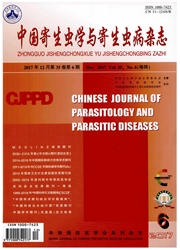

 中文摘要:
中文摘要:
目的探讨湖沼型地区钉螺种群的空间格局。方法2005年10月、2006年4月及11~12月,随机选取安徽省池州市贵池区秋浦河沿岸的4块滩地设框查螺,分别计算钉螺的平均拥挤度(m*)、平均密度(m)、聚集指标[包括:扩散系数(C)、扩散型指数(Iδ)和聚集度指数(m*/m)]、Taylor的(lgS2-lgm)回归指数以及Iwao的m*-m回归指数。结果不同时间4块滩地钉螺的C、Iδ和m*/m指数均〉1;Taylor的lgS2-lgm回归指数中的lgm与lgS2有明显的线性关系(r=0.972,P〈0.01),lga=0.602,b=1.427;Iwao的m*-m回归指数中的m*与m呈明显的线性关系(r=0.984,P〈0.01),α=2.367,β=1.617。结论湖沼型地区钉螺种群的空间格局为聚集分布,分布的基本成分是个体群。
 英文摘要:
英文摘要:
Objective To explore the spatial pattern of the distribution of Oncomelania hupensis population in marshland and lake region. Methods Four bottomlands were selected randomly for the investigation along the Qiupu River in Guichi District, Anhui Province. The quadrats were placed randomly for snail survey, and the mean crowding, mean density, aggregation indices (diffusion coefficient(C), morisita index(Is), index of patchiness(m*/m)), Taylor's power law and Iwao's m*-m regression index were analyzed. Results For 4 bottomlands in different time, the diffusion coefficients, Morisita indices, and m*/m indices were all more than one. There was a close linear relationship between the logarithm of the snail density and its variance (P〈0.01), and the correlation coefficient was 0.972. In Taylor's power law, the lg a was 0.602 and b was 1.427. There was a close linear relationship between the mean crowding(m*) and the snail density(m) (P〈0.01), and the correlation coefficient, α and β was 0.984, 2.367 and 1.617 respectively. Conclusion The spatial pattern of Oncomelania hupensis population shows an aggregation distribution in marshland and lake region, and the basic components of snail distribution are in colonies.
 同期刊论文项目
同期刊论文项目
 同项目期刊论文
同项目期刊论文
 Harnessing the wealth of Chinese scientific literature: Schistosomiasis research and control in Chin
Harnessing the wealth of Chinese scientific literature: Schistosomiasis research and control in Chin An integrated approach to identifydistribution of Oncomelania hupensis, the intermediate host of Sch
An integrated approach to identifydistribution of Oncomelania hupensis, the intermediate host of Sch Generalized negative binomial distribution: A promising statistical distribution for Oncomelania Hup
Generalized negative binomial distribution: A promising statistical distribution for Oncomelania Hup A longitudinal study of comparison of the Kato–Katz technique and indirect hemagglutination assay (I
A longitudinal study of comparison of the Kato–Katz technique and indirect hemagglutination assay (I Settlement extraction over North China Plain with Landsat and Beijing-1 data using an improved water
Settlement extraction over North China Plain with Landsat and Beijing-1 data using an improved water Invasive Snails and an Emerging Infectious Disease: Results from the First National Survey on Angios
Invasive Snails and an Emerging Infectious Disease: Results from the First National Survey on Angios Landscape pattern analysis and Bayesian modeling for predicting Oncomelania hupensis distribution in
Landscape pattern analysis and Bayesian modeling for predicting Oncomelania hupensis distribution in Identifying high risk areas of schistosomiasis and associated risk factors in the Poyang Lake region
Identifying high risk areas of schistosomiasis and associated risk factors in the Poyang Lake region Concepts in research capabilities strengthening positive experiences of network approaches by TDR in
Concepts in research capabilities strengthening positive experiences of network approaches by TDR in Remote sensing and geographic information systems in the spatial temporal dynamics modeling of infec
Remote sensing and geographic information systems in the spatial temporal dynamics modeling of infec A growing degree-days based time-series analysis for prediction of Schistosoma japonicum transmissio
A growing degree-days based time-series analysis for prediction of Schistosoma japonicum transmissio Geo-spatial hotspots for hemorrhagic fever with renal syndrome and genetic characterization of Seoul
Geo-spatial hotspots for hemorrhagic fever with renal syndrome and genetic characterization of Seoul Design and application of the emergency response mobile phone-based information system for infectiou
Design and application of the emergency response mobile phone-based information system for infectiou Spatial epidemiology in zoonotic parasitic diseases: insights gained at the 1st International Sympos
Spatial epidemiology in zoonotic parasitic diseases: insights gained at the 1st International Sympos Landscape elements and Hantaan virus–related hemorrhagic fever with renal syndrome, People’s Republi
Landscape elements and Hantaan virus–related hemorrhagic fever with renal syndrome, People’s Republi Strategy formulation for schistosomiasis japonica control in different environmental settings suppor
Strategy formulation for schistosomiasis japonica control in different environmental settings suppor Field comparison of immunodiagnostic and parasitological techniques for the detection of schistosomi
Field comparison of immunodiagnostic and parasitological techniques for the detection of schistosomi Comparison of the Kato-Katz technique, hatching test and indirect hemagglutination assay (IHA) for t
Comparison of the Kato-Katz technique, hatching test and indirect hemagglutination assay (IHA) for t Key differntiating features between scrub typhus and hemorrhagic fever with renal syndrome in northe
Key differntiating features between scrub typhus and hemorrhagic fever with renal syndrome in northe Spatio-temporal correlation between human and bovine schistosomiasis in China: insight from three na
Spatio-temporal correlation between human and bovine schistosomiasis in China: insight from three na 期刊信息
期刊信息
